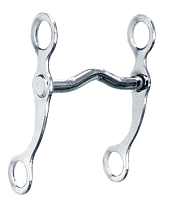mouth, the curb bit will actually multiply your two
ounces by as much as four times! Thus, it is wise to know the kind of pressure
your horse will feel before actually applying it to the animal. the curb bit will actually multiply your two
ounces by as much as four times! Thus, it is wise to know the kind of pressure
your horse will feel before actually applying it to the animal.It is not surprising that horse enthusiasts eye the curb bit with a bit of
trepidation. The tool itself consists of a mouthpiece which as a shank located
on either side. You will be able to attach a bridle or curb chain to the upper
shank, while the reins can be attached to the lower shank. What makes this
devise so functional is the fact that it gains its power from rotation, allowing
one shank to go back and the top to go forward. The chain will squeeze the jaw,
subsequently letting the bridle apply pressure to the poll.
Considering the kind of power you will be able to exercise with the curb bit,
you will need to be wise in selecting the right kind of bit for you. There is
the Pelham which is nothing more than a curb bit with a curb rein as well as a
snaffle rein, thus being useful as either bit. Of course to fully use it to your
advantage you will need to refrain from pulling on both reins simultaneously.
The other device on the market is the Kimberwicke which is considered a gentle
kind of curb. Last but not least is the full bridle which is simply a
combination of a snaffle and a curb bit. The goal of this setting permits the
snaffle to exercise control of the animal while the curb portion permits the
horse to remain collected. This latter implement is perhaps the hardest kind to
use and should only be done by someone well trained in using such instruments of
control. Of course, if applied incorrectly, even the mildest kind of curb can be
harsh!
When you are ready to pick out a curb, keep in mind the size and shaping of the
mouthpiece; for example a smooth port that angles backward a little is more
easily accepted by a horse than other kinds, including a straight bar.
Similarly, if it is too large it will rock from side to side, creating a
possibility for injury and lack of control. It may take a bit of tinkering to
figure out just which mouthpiece will work best for your animal. By way of
suggestion, a curb bit should have a somewhat thick mouthpiece but it should not
be overly. Additionally, stay away from the bits that exert pressure downward,
since it will injure the animalís tongue. Even the selection of material is
important. Aluminum Ė although cost effective Ė should be avoided because of the
bad taste it will leave in the animalís mouth.
Once you have selected the appropriate curb bit that will work for your horse,
take some time to properly fit the curb chain. This fitting should permit the
bit to rate back 45 degrees; while there is no hard and fast rule of thumb,
there is the general suggestion that two fingers between the curb chain and the
animalís chin are a good place to start. Additionally, make sure that there are
no knotted or twisted materials underneath the animalís jaw.
To gage your success with this bit, you will want to observe the animal when you
are stopping: if it is throwing back its head, the bit may need to be adjusted
or replaced with one that fits better.
 |